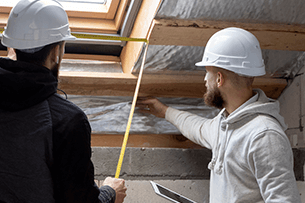How to Spot Hail Damage
How is hail formed?
Hail is formed when upward air currents in thunderstorms carry raindrops into the upper-level clouds when temperatures drop below the freezing point. The frozen drops build into bigger pellets, usually forming around a central core which could either be a tiny ice crystal, a speck of dust, a frozen raindrop, or any other central core. These frozen ice particles descend lower within the cloud when the temperatures drop below freezing temperatures. Here they pick up more moisture from the surrounding precipitation and water vapor. After getting caught in another updraft, they refreeze and the cycle starts again.
When these particles repeat their cycle of going up and down in the updrafts, they grow heavier and heavier until gravity pulls them down toward the ground. As these particles grow bigger and plummet toward the ground, they build a lot of energy and velocity. Baseball-sized hailstones often fall at the speed of nearly 100 miles per hour. These stones then inflict a lot of damage on people or property.
What are a few signs of hail damage on a roof?
Different roofs and different materials react differently when struck by hail. Shingles take the force of hail damage differently as compared to asphalt. A flat roof vs a slanted roof will react differently to hail damage. It is crucial to be able to identify the different effects of hail on
different roofing materials to assess whether you actually have
roof damage
from hail. Most hailstorms are destructive but the amount of damage inflicted can vary greatly depending on the intensity of the storm. Damage can be functional or cosmetic, and if you aren’t attentive about the damage, it can cause serious complications.
A quick checklist of signs of hail damage:
- Dented gutters, gutter screens, or downspouts
- Damaged siding and window casings
- Damaged air conditioners
- Damaged decks or painted wood surfaces
- Damaged roof vents and shingles
- Damaged fencing
- Dented metal surfaces
Dented gutters, gutter screens, or downspouts:
While not very common, you might sometimes find significant damage and impact of the hailstones on the gutters. Damaged gutters and gutter guards often show dent marks or scratch marks after facing damage from hail. Keep an eye out for scratched paint on gutter guards or denting on any vents that stand out from your roof.
Damaged siding and window casings:
Also check your home’s siding and window casings for any dents, scratches or dings, or any other signs of hail damage. Keep a lookout for certain spots that are indicative of more damage on the roofs, like window casings or sidings.
Damaged air conditioners:
Check every corner of your home including the air conditioners for wear and tear. You may also qualify for insurance replacement if your air conditioner has faced hail damage. Make sure you get it professionally inspected to follow through with the claim process in a systematic manner.
Damaged decks or painted wood surfaces:
These are the areas you can check for signs of hail damage without getting on the roof. Some of the tell-tale signs of hail damage are seen on the chipped paint on the decks of your home or other painted wood surfaces.
Damaged roof vents and shingles:
Hits from hail on the roof can cause cracks of all sizes on the shingles. Check for dents or cracks in the shingles. Heavy hail damage over a long period of time can damage shingles to the point where the shingles dry and curl up like dried-out leather. These shingles can then fall off from the roof and leave the roof exposed.
Granules can often come loose after a hail storm, the proof of which you will find in the gutters or downspouts. When these granules fall off, the strength of the shingles can be reduced leading to more shingles falling off, leaving the roof exposed. It is important to check for these signs of hail damage to fully understand the level of damage within the roof.
Damaged fencing:
Various signs of hail damage can be spotted while on the ground. Signs like surface dents, paint chipping off, cracks, etc are indications of damage sustained by the roof. Before you climb on the roof check for these signs of damage from the ground to avoid risk. Damaged shingles can be loose and likely to fall off, making it less than ideal for you to climb the roof for inspection. Always contact professional roofing contractors for getting your roof inspected after storms and once before the winter sets in.
Damaged metal surfaces:
Vents, chimneys, skylights, shingles, and other metal surfaces can sustain hail damage and often are indicators of wreckage in the inner structure of the roof. It is important to have these checked to understand the extent of damage sustained by the roof.
What size of hail stones can cause roof damage?
Various studies and surveys have shown the potential damage to roofs is dependent on the size of the hail stones. This depends not only on the size of the hailstone but also on the material of the roof. There is some common correlation between the size of the hailstone and the damage it can cause, as observed in field observations and ice stone impact tests.
The hail damage to property can be functional or cosmetic. However, the cosmetic bruises to the roof are often indicative of damage to the structure and should always be checked out. Functional damage reflects the compromise integrity and longevity of the roof structure.
How to repair a roof with hail damage?
Based on a preliminary inspection of the cosmetic and functional damage of the on-ground and off-ground elements, if you still are unclear, contact professional roofers at Basswood Roofing. Don’t delay inspections or repairs, especially after a hailstorm as it can lead to more long-term damage or structural damage to the roof. Go through the insurance claim process and make sure to file for a claim after you inspect the roof - either using your own tools or via professional roofers.






















